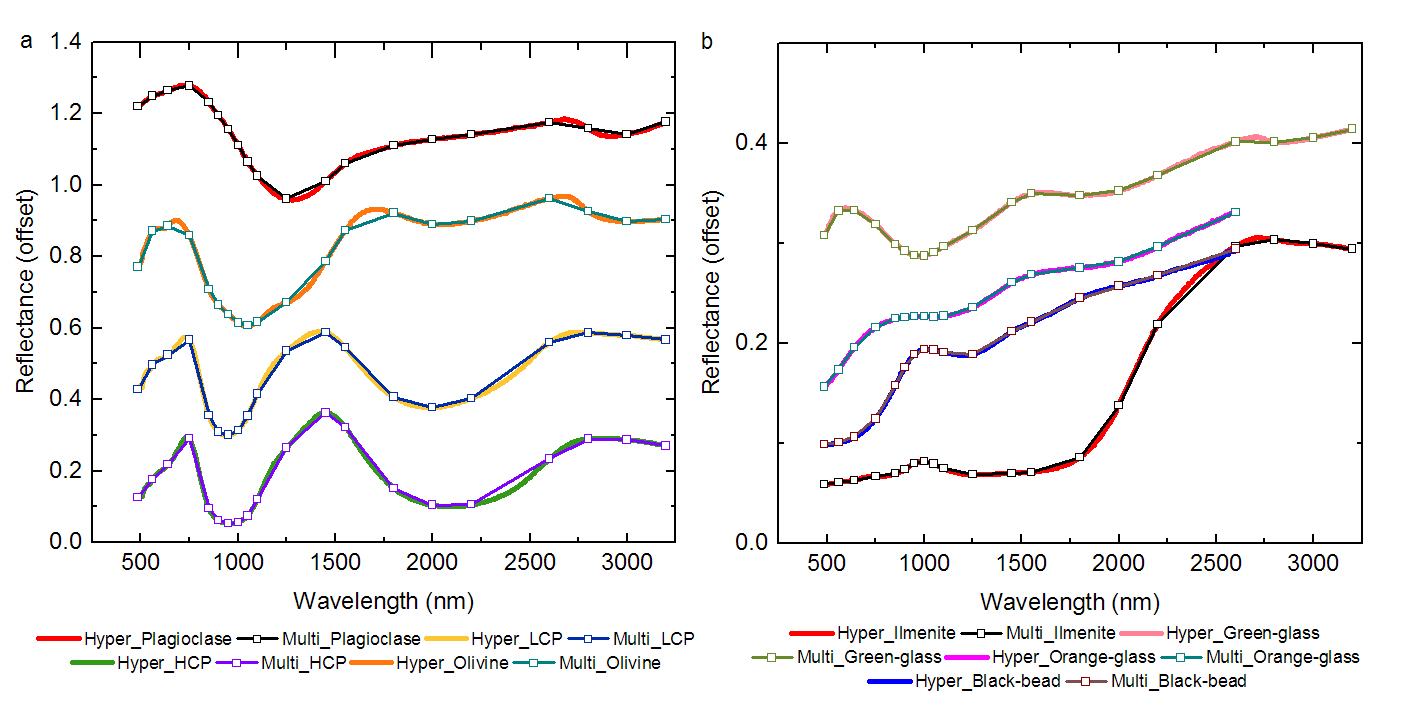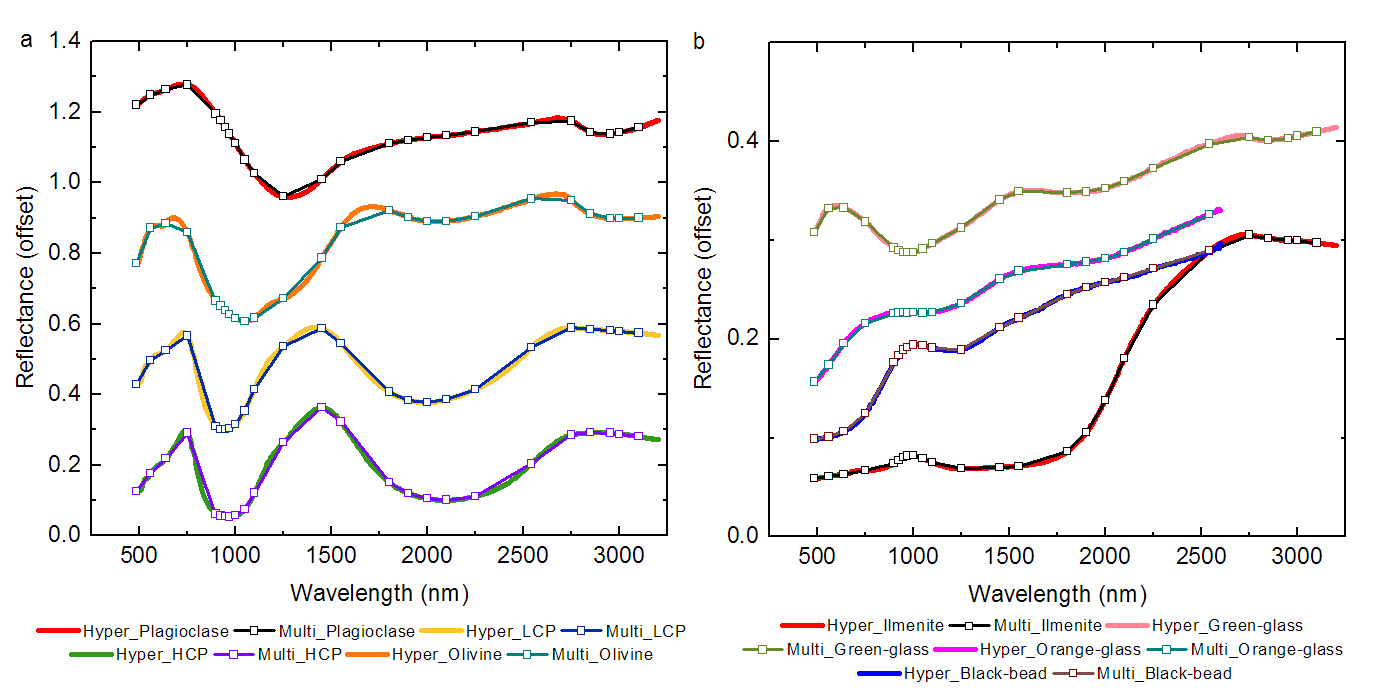Bands Selection for Multispectral Detection Mode of Lunar Mineralogical Spectrometer of China’s Chang’E-5 and Chang’E-6 Missions
- National Astronomical Observatories, Chinese Academy of Sciences, Beijing, China (liudw@nao.cas.cn)
Introduction: In December 2020, China’s Chang’E-5 (CE-5) mission successfully landed in the northeastern part of Oceanus Procellarum on the Moon and achieved its goal of collecting lunar surface samples[1]. Chang’E-6 (CE-6) is China’s second lunar sample return mission following the CE-5 mission, and were launched on 3rd May 2024 . The CE-6 landing zone has been selected to lie within the lunar farside South Pole–Aitken (SPA) basin in the southern part of the Apollo basin[2]. Both CE-5 and CE-6 missions are equipped with the Lunar Mineralogical Spectrometer (LMS) to conduct surface spectral scanning to obtain the mineralogical infromation of the sampling area. The LMS can acquire hyperspectral data from 480 nm to 3200 nm[3]. Due to in-orbit working time and condition limitations, LMS could not complete whole sampling area scanning using hyperspectral detection mode and has to adopt multispectral detection mode. In this study, we mainly introduced the design of band selection for the LMS multispectral detection mode.
Designed LMS multi-bands for CE-5 mission: Remote sensing data reveals that the spectra of the CE-5 landing area exhibit longer-wavelengths ~1 μm and 2 μm absorptions, indicating that the CE-5 mare basalts are primarily composed of high-Ca pyroxene (HCP). Spectra of CE-5 landing area also show a much weaker 2 μm absorption relative to their 1 μm absorption, resembling the spectral characteristics of olivine[5]. In addition, CE-5 landing area contains a large amount of ejected materials from surrounding regions, including basaltic materials dominated by low-Ca pyroxene (LCP) from western old IM basaltic regions and materials dominated by plagioclase from the eastern highlands. Products associated with volcanic activity such as volcanic glass and ilmenite are also likely to contribute to the material in CE-5 landing area. Considering the spectral features of these mineral/glass and taking into account wavelength positions that can be used to estimate Fe, Ti and maturity as well as OH-/H2O, we finally selected 20 bands combination for CE-5 LMS (Table 1).
Optimization of multi-bands for CE-6 mission: The pyroxene composition of CE-6 landing area has changed significantly, ranging from Mg-rich LCP to Fe, Ca-rich HCP[2]. Spectral interpretation of pyroxene compositions of CE-6 landing area will greatly influence the analysis of the origin of the returned samples (mantle or lower crust). Therefore, for CE-6 mission, we increased the number of the selected bands around ~1 μm and 2 μm absorption to more accurately dipict the variation of absorption center of lunar soils resulting from the changing composition of pyroxene. Besides, to better characterize OH-/H2O absorption, we optimized the positions and increased the number of bands for 2200 nm-3200 nm regions (Table 1).
Evaluation on displaying spectral features:
In general, the designed multi-bands can well display the hyperspectral features (measured by RELAB) of mineral/glass separated from lunar soils. LCP exhibits a shorter-wavelength absorption ~2000 nm, consistent with its hyperspectral data. HCP shows a flattening between ~2000 nm and ~2200 nm, indicating that its absorption center should be located between these two bands. The multispectral data allows for the effective display of olivine’s broader 1 μm absorption, and the hyperspectral features of the three types of lunar volcanic glasses are also well reproduced, particularly the longward 1 μm and shortward 2 μm wide absorptions. Compared to the multi-bands spectra of CE-5, the designed bands combination for CE-6 seems to be more efficient in reflecting the absorptions around ~2 μm and ~2.8 μm because of the optimization and increased number of bands selected for these two spectral regions.
References: [1] Li C. et al. (2022) NSR, 9, 2, nwab188. [2] Zeng X. et al. (2023) Nature Astronomy, 7, 1188-1197. [3] He Z. (2019) J. Appl. Remote Sens, 13(2). [4] Liu D. et al. (2002) Nature Communictions,13, 5965. [5] Staid M. I. et al. (2011) J. Geophys. Res. Planets, 116, E6.

Figure 1. Comparison between hyperspectral and multispectral data of minerals and glasses composing lunar soils. The multispectra were obtained by re-sampling the hyperspectra according to the spectral response function of CE-5 LMS multispectral detection mode.

Figure 2. Comparison between hyperspectral and multispectral data of minerals and glasses composing lunar soils. The multispectra were obtained by re-sampling the hyperspectra according to the spectral response function of CE-6 LMS multispectral detection mode.
Table 1 Designed LMS multi-bands
|
CE-5 (nm) |
CE-6 (nm) |
Main Application |
|
485 |
485 |
Ilmenite, TiO2 |
|
560 |
560 |
Ilmenite, TiO2 |
|
640 |
640 |
Ilmenite, Black bead |
|
750 |
750 |
1μm absorption shoulder, maturity, FeO and TiO2 |
|
850 |
|
olivine |
|
900 |
900 |
LCP |
|
|
925 |
LCP |
|
950 |
950 |
LCP/HCP, maturity, FeO and TiO2 |
|
|
970 |
HCP |
|
1000 |
1000 |
HCP |
|
1050 |
1050 |
HCP, olivine |
|
1100 |
1100 |
olivine, volcanic glass |
|
1250 |
1250 |
olivine, plagioclase, volcanic glass |
|
1450 |
1450 |
1μm absorption shoulder, olivine |
|
1550 |
1550 |
1μm or 2μm absorption shoulder, plagioclase |
|
1800 |
1800 |
LCP |
|
|
1900 |
LCP |
|
2000 |
2000 |
LCP/HCP |
|
|
2100 |
HCP |
|
2200 |
|
HCP |
|
|
2250 |
HCP |
|
|
2540 |
LCP/HCP shoulder, OH-/H2O shoulder |
|
2600 |
|
OH-/H2O shoulder |
|
|
2750 |
OH-/H2O shoulder |
|
2800 |
|
OH-/H2O |
|
|
2850 |
OH-/H2O |
|
|
2950 |
OH-/H2O |
|
3000 |
3000 |
OH-/H2O |
|
|
3100 |
OH-/H2O |
|
3200 |
|
OH-/H2O |
How to cite: Liu, D., Liu, B., Liu, J., Zhang, H., Su, Y., Zhu, X., and Li, C.: Bands Selection for Multispectral Detection Mode of Lunar Mineralogical Spectrometer of China’s Chang’E-5 and Chang’E-6 Missions, Europlanet Science Congress 2024, Berlin, Germany, 8–13 Sep 2024, EPSC2024-349, https://doi.org/10.5194/epsc2024-349, 2024.